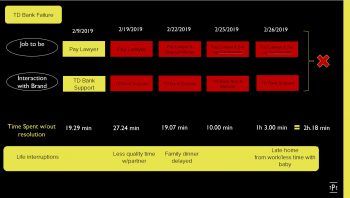Although we all have bad customer experiences, there is still a big debate about “the CX field” and whether it will survive the test of time. There is no doubt in my mind that customer experience is here to stay. The brands that catch on to this truth will be our service providers in the future.
Do you need an example to make your business case in the board room? By all means, use our recent horrible experience with TD Bank Small Businesses Banking.
Understanding Customers’ Needs is a Bare Minimum for Brands
In his CCXP prep book, Michael Bartlett talks about the concept of jobs-to-be-done. Those jobs are customers’ needs. And they should be the drivers of the market (vs. products of industries). In this sense, a job could be paying a lawyer, making a bank deposit or linking a bank account to Quickbooks. According to Bartlett, understanding these jobs helps a brand understand its customers and deliver better customer experience.
How does this relate to our TD Bank experience? We are a small consulting business with a business bank account there. All of the above examples are core needs we have that are still not met by the bank.
After such bad experience and no working policies or procedures for recovery, TD Bank probably lost a customer tonight. To make things worse, my business partner and I both already have existing personal banking relationships with TD Bank. This is an example of severe loss for TD. The bank did not just lose a new customer. It lost two loyal customers that have a pretty high lifetime value. Our business will only going to grow…
So, what happened?
No business or CX integration
TD Bank offers only one way for a small business to make a payment free of charge. Following the product design incentives, we chose that method – Bill Pay. Apparently, our payment of less than $2,500 was flagged by the third party system that processes the transaction for TD Bank. They locked our online access to the business account. By itself that is not a problem if that event was communicated and fixed through customer support. Instead, TD Bank did not reach out through any channel to inform us that: 1) our vendor is not getting paid; 2) we no longer have access to our account.
Since this product is managed by a “partner” of TD Bank the bank’s customer support is NOT empowered to fix customers’ problems with this service. It is not even clear if they have the ability to see what happens to their own customers. Allegedly, the vendor called me to ask me to validate the payment. Since I did not happen to pick up the phone, I was out of luck. Below you can see my analysis of the emotional and personal cost I paid to recover my experience with no success. We are still locked out of the account.

Source: The Petrova Experience
Procedure without the customer in mind
Let’s look at this example through the procedures lenses.
Flagging an amount of less than $2,500 for a small business account is not a practical procedure. Monitoring accounts for fraud and making sure our funds are safe is one thing. Designing very conservative procedures that restrict the access to liquidity and limit the ability to do business is counter intuitive to the product value of “small business banking.” Even if there is more to the reason why this particular transaction was flagged. TD Bank should be able to provide clarity on that issue. At least that is what is expected from a transparent brand today.
Instead, the three people we have spoken with have not been able to answer our questions the same way. It seems like there is no procedure for our incident since they also had different answers on next steps. Escalation also did not work here. Their supervisor had to follow a procedure that did allow him to call me or text me or email me back with an update.
System integration without customer journeys
It is clear that the integration of TD Bank and the Bill Pay System was not designed with the customer in mind.
Nobody thought about the customer experience or recovery. And there are no procedures, documentation, or access in place for TD Bank customer support agents to communicate or resolve customer issues proactively.
Now, if my Bill Pay was a really rare customer job (paying somebody) in a bank, I can understand leaving this as is. The 80% / 20% rule does not allow for perfect design for all transactions. But since we know this is the only FREE way to pay people, I can imagine this is more of the 80% jobs of small businesses.
After two hours on the phone with three different agents and one supervisor, we still have no access to our small business bank account. We have not been able to pay our lawyer, deposit money, set up our new accounting system, or manage our finances properly. From a brand perception perspective, we have had five different touch points, more than half of which have been negative and none of which were successful.
Prove It
This experience is a great example of ROI that you will have a hell of a time proving to your CEO when you ask for complete integration that includes UX for your support team so they can actually assist customers.
It may also help you get some funding to revise your procedures with the customer in mind vs. regulatory requirements alone. Last, but not least, perhaps you will be able to fund a phone system and procedure that will allow the supervisor I spoke with tonight the ability to CALL ME BACK to tell me what he did. Apparently, the money did not cover that feature…
Signed,
A detractor with a loud voice.



